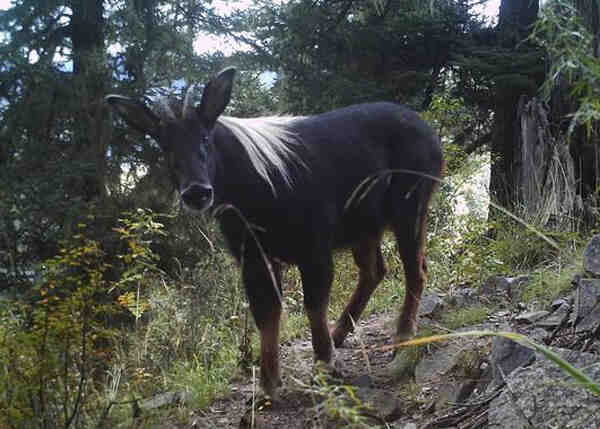Capricornis milneedwardsii
IUCN
LCBasic Information
Scientific classification
- name:Capricornis milneedwardsii
- Scientific Name:Capricornis milneedwardsii,Chinese Serow,Four-legged beast, Sumatran serow
- Outline:Ungulata
- Family:Artiodactyla Ruminantia Bovidae Caprinae Serow
Vital signs
- length:140-170cm
- Weight:85-140kg
- lifetime:About 15 years
Feature
The prototype of the ancient "Sky Horse"
Distribution and Habitat
Distributed in Cambodia, China, Laos, Myanmar, Thailand, and Vietnam.
In China, it is mainly distributed in Gansu, Qinghai, Zhejiang, Anhui, Hubei, Jiangxi, Sichuan, Yunnan, Tibet, Fujian, Guangdong, and Guangxi.
It mainly lives in coniferous and broad-leaved mixed forests, coniferous forests, or rocky shrub forests at an altitude of 1,000 to 4,400 meters.
Appearance
The head and body are 140 to 170 cm long, the shoulder height is 90 to 100 cm, the tail length is 115 to 160 mm, the ear length is 175 to 205 mm, the total skull length is 280 to 320 mm, and the weight is 85 to 140 kg. It is tall and has long legs, dark hair color, short horns that bend backwards, and long and fluffy manes on the back of the neck that form a thick hair ridge extending to the back. It has prominent preorbital glands, short tail hair, and black-gray or red-gray body hair color, especially on the long manes and legs, the hair is coarse and the hair layer is thin. The Sichuan subspecies has black manes.
Both males and females have short and smooth black horns. The ears are like donkey ears, narrow and pointed. There are more than ten centimeters of gray-white hair from the base of the horns to the back of the neck, which is very obvious. The tail is short and the limbs are short and thick, which is suitable for running and jumping among the rocks on the cliffs. The whol
Details
Chinese Serow, also known as Chinese Serow in English, has two subspecies and is one of the typical animals in the tropical and subtropical regions of southeast Asia.

The horns of the Chinese serow look like a deer, but it is not a deer; the hooves look like a cow, but it is not a cow; the head looks like a sheep, but it is not a sheep; the tail looks like a donkey, but it is not a donkey. Therefore, people call it "four-unlike" together with reindeer, moose and elk. The Chinese serow looks like a sheep, but has longer and thicker horns and a larger horizontal ridge than the goral. The Chinese serow is much larger than the goral (Naemorhedus goral) and much smaller than the antelope (Budorcas taxicolor).
The ancient people in my country believed that there would be traces of "heavenly horses" in Huangshan. According to the records in Huangshan Chronicles: "Heavenly horses often fly over the peaks of Tiandu Lotus, with silver manes and golden hairs, and four feet holding auspicious clouds, and their whiskers jump over dozens of peaks." This shows that this creature can run freely on cliffs and has the momentum of "riding clouds and mist", which is why it can be called "heavenly horse". Later, after scholars studied the "Huangshan Heavenly Horse", they finally found that it was the Chinese serow.
Chinese serows usually live in forests in winter and move to high-altitude cliffs in summer. They live alone or in small groups, mostly active in the morning and evening, and are agile and run very quickly among rocks. They feed on grass, twigs and leaves, and like to eat fungi. They feed on leaves and seedlings of various plants and lick salt in saline areas. Sometimes they sleep in regular low-lying places, and sometimes they rest on raised areas with good views.
Chinese serows mate in autumn, with a gestation period of 7 to 8 months, and give birth to one or sometimes two cubs per litter.
Like other forest animals, the habitat of Chinese serows has been destroyed as forests in its distribution area have been cut down in large quantities. In addition, because the Chinese Serow is large in size, can provide more meat, and its skin is of high quality, it is often over-hunted.
Listed in the "Red List of Threatened Species of the World Conservation Union" (IUCN) 2008 ver 3.1 - Near Threatened (NT).
Listed in the "Red List of Chinese Species" - Vulnerable (VU).
Listed in the "List of National Key Protected Wildlife in China" - Level II.
Listed in the "Red Book of Endangered Animals in China" - Vulnerable (VU).
Listed in the Convention on International Trade in Endangered Species of Wild Fauna and Flora (CITES) - Level I.
Protect wild animals and eliminate game.
Maintaining ecological balance is everyone's responsibility!








